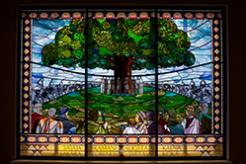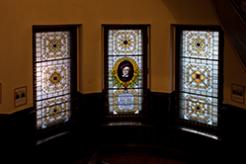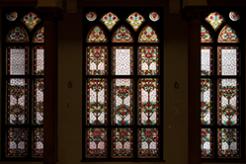




Author: Ilona Audere
Throughout the Art Nouveau period in Riga, in addition to the achievements of German stained glass workshops, we can also see the first professional works of Latvian stained glass makers. Art Nouveau buildings required not only artistic glasswork made according to individual sketches, but also industrially produced stained glass with popular motives of flora and geometric shapes. Glass is a fragile material, therefore very few original samples of stained glass remain, especially when we consider the location of Art Nouveau windows in Riga’s buildings, their destiny and the fact that many of these houses were taken care of by irresponsible people. There are even fewer samples of copyrighted stained glass works made by artists of Riga. Since stained glass windows made according to sample books were neither dated nor signed, they give us no information on their original place of production. We can however assume that in most cases the decorative Art Nouveau windows were created at the same time as the buildings they were placed in, or soon after the buildings were built. We could acquire additional information from personal family archives, if any order receipts, letters, etc. had been saved. Unfortunately, so far we have been unable to locate any. Similar windows could have been made by any of the then operating workshops in Riga. J. Beiermann’s workshopshould be mentioned, because it received the majority of orders and operated for a very long time, spanning several generations – since 1747 until 1939, specialising in glass painting. The workshop of Alfred Kahlert operated in Riga since the 1890s as Alfred Kahlert and Franz Weber’s workshop; from 1900 until 1939 it operated only as Alfred Kahlert’s workshop, producing both religious and secular compositions in their contents as well as ornamental painted compositions and mosaic windows. Ernst Friedrich Tode may be considered the most popular and professional stained glass maker in Latvia; he worked in Riga from 1895 until 1909. The workshop of E. Baumann-Fromhold operated until 1944. Whereas, the artistic stained glass and matt workshop of A. Schwolkowsky operated in Riga until 1930. It is interesting to note that several Latvian stained glass craftsmen mastered their craft in these German workshops in the first decade of the 20th century. Some of them opened their own workshops at the beginning of the 20th century – J. Krīgers, E. Vainovskis (students of A. Schwolkowsky), A. Lilientāls (student of Alfred Kahlert). Hermanis Grīnbergs and Jēkabs Šķērstēns studied for several years in the workshop of Ernst Tode.
More information will be available in the virtual exhibition, which will be established till April 2016.